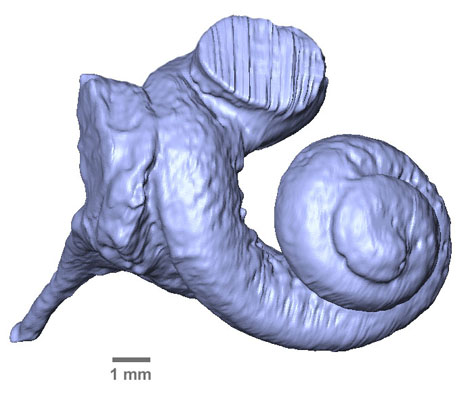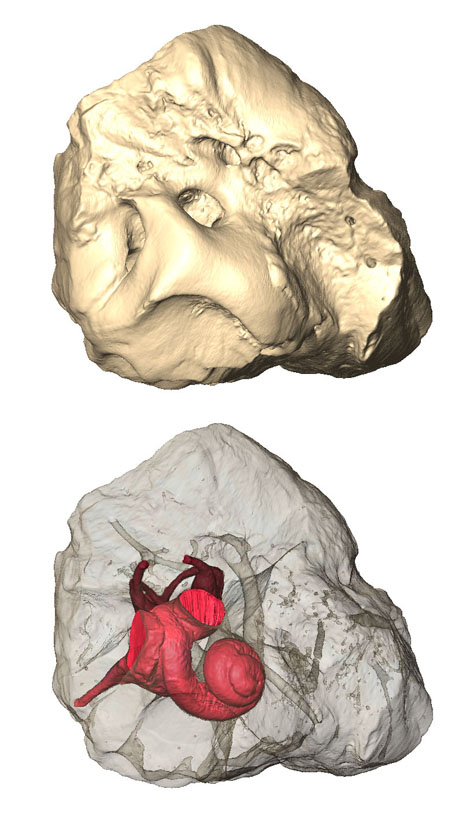
Audibility range of first whales
The hearing organ of the earliest whales, or protocetids, has been digitally reconstructed by paleontologists from the Institut des sciences de l'évolution de Montpellier (CNRS / Université de Montpellier / IRD / EPHE)1 . Despite their essentially aquatic lifestyle, these extinct cetaceans had hind legs that allowed them to move about on land. Virtual casts of the protocetid cochlea, the organ central to hearing, suggest that their auditory ranges were very different from those of their modern cousins.
- 1The CNRS and the EPHE are both members of the PSL Research University consortium.
Protocetids - legged whales that became extinct 38 million years ago - gave rise to two major groups of modern whales that differ considerably in their means of communication and hearing abilities. Baleen whales (Mysticeti) can pick up low frequencies and use infrasonic calls to communicate over very long distances. On the other end of the spectrum, toothed whales (Odontoceti) produce ultrasound for echolocation.
Until now, two contradictory hypotheses posited a common ancestor with special hearing abilities: one hypothesis suggested sensitivity to infrasound; the other, to ultrasound. In a study published by Current Biology on June 8, 2017, Mickaël Mourlam and Maeva Orliac, paleontologists at the Institut des sciences de l'évolution de Montpellier (CNRS / Université de Montpellier / IRD / EPHE), advance an alternative theory about the evolution of cetacean hearing.
The two researchers trained a micro-CT scanner on fossilized protocetid skull fragments to prepare 3D virtual casts (digital endocasts) of the extinct animals' cochleae, which are the main hearing organs. The fossils, remains of primitive whales living roughly 45 million years ago, came from a Togolese phosphate mine and were held in the collections of the Université de Montpellier. Mourlam and Orliac's study shows that the shape and characteristics of protocetid cochleae differ markedly from those typical of the two large modern cetacean groups. The implication is that specialization for infrasonic or ultrasonic hearing only occurred at a later point, among modern whales, after the evolutionary divergence of Mysticeti and Odontoceti.
Protocetid hearing abilities were most likely similar to those of their hoofed terrestrial cousins: neither infrasonic nor ultrasonic. This would suggest that early whales did not use echolocation or communicate over long distances with low-frequency sounds like today's whales, which is consistent with the assumption that protocetids preferred living near the shore. According to the new evolutionary scenario described by the two paleontologists, the common ancestor of all cetaceans also did not have specialized hearing abilities but instead registered sounds in a range ideally suited for its amphibious life.
These findings underscore the importance of studying early cetaceans to understand how this extraordinary mammalian group adapted to aquatic life. Protocetids offer us a clearer picture of cetacean evolution, which is more complicated than previously thought. Mourlam and Orliac have only studied the ears of two of the three fossil species found in Togo. During their next mission in December, they hope to lay their hands on a fossil that will let them peer into the ears of the third species.

Digital cochlear cast, ventral view, for Carolinacetus sp. (specimen UM-KPG-M164), one of the protocetid species discovered in Togo.

Top: Digital cast of petrosal bone for ?Carolinacetus sp. (see Figure 1 legend). Bottom: In situ cochlea (shown in bright red) visible through translucent rendering of petrosal bone, ventral view.
Infrasonic and ultrasonic hearing evolved after the emergence of modern whales, Mourlam MJ, Orliac MJ, Current Biology, 2017 June 8. doi:0.1016/j.cub.2017.04.061.


